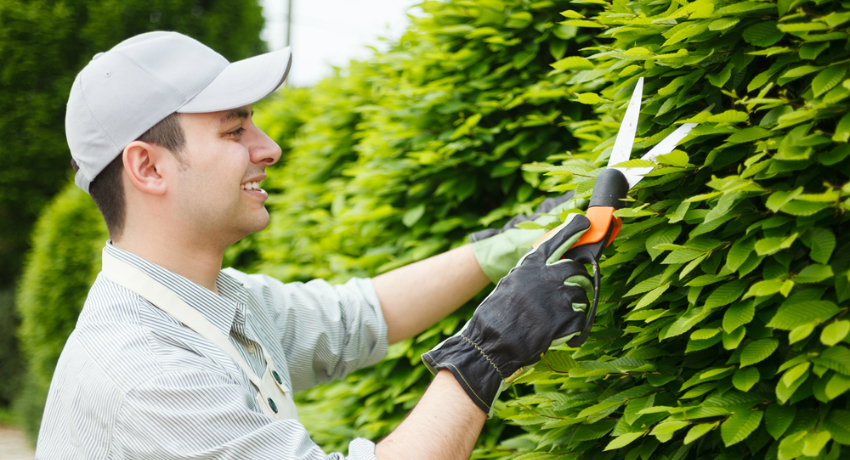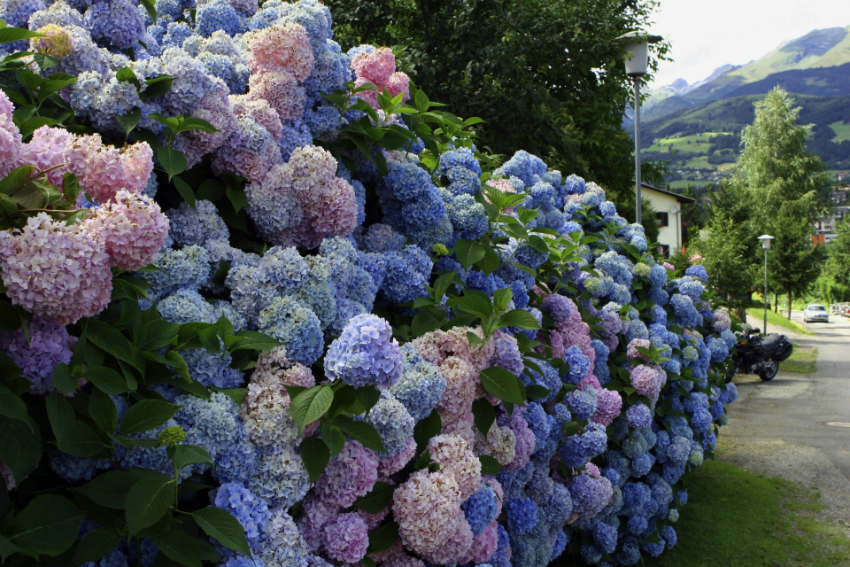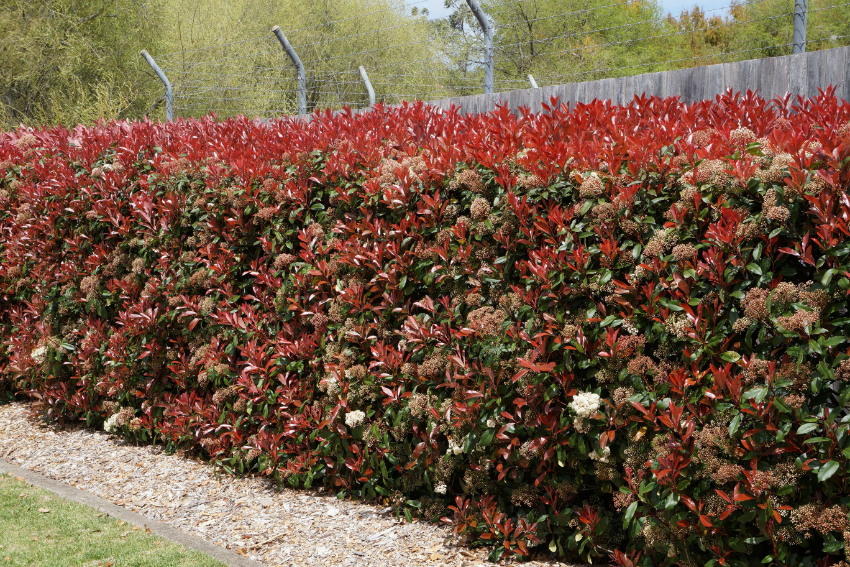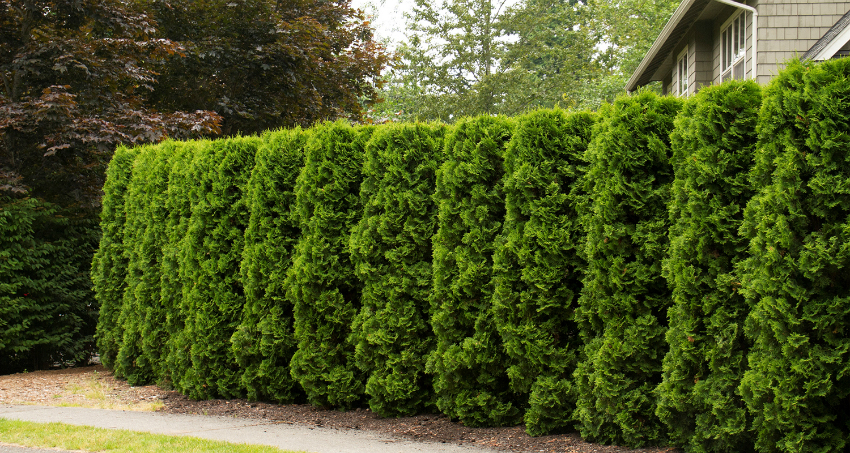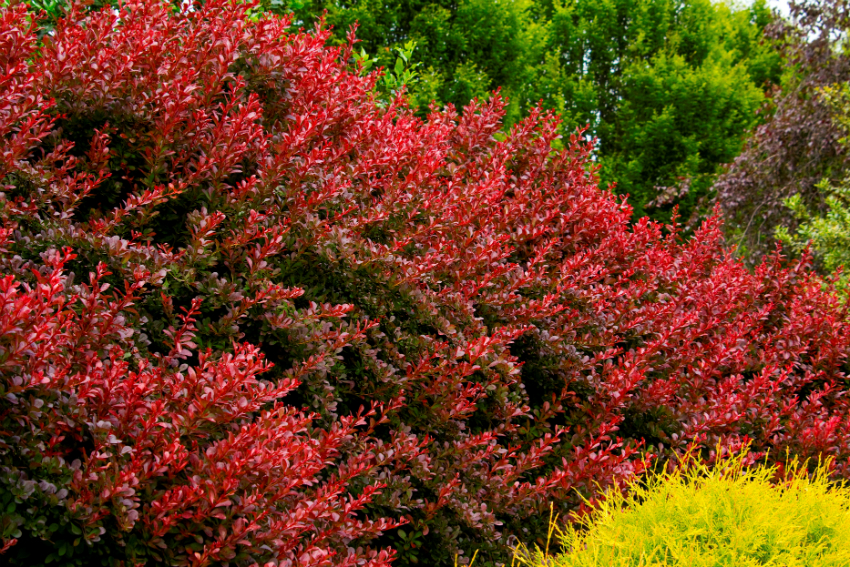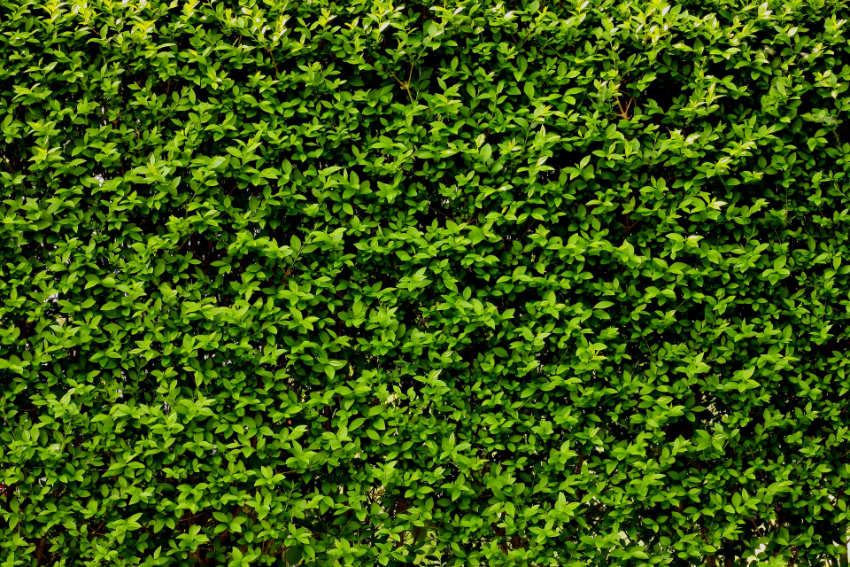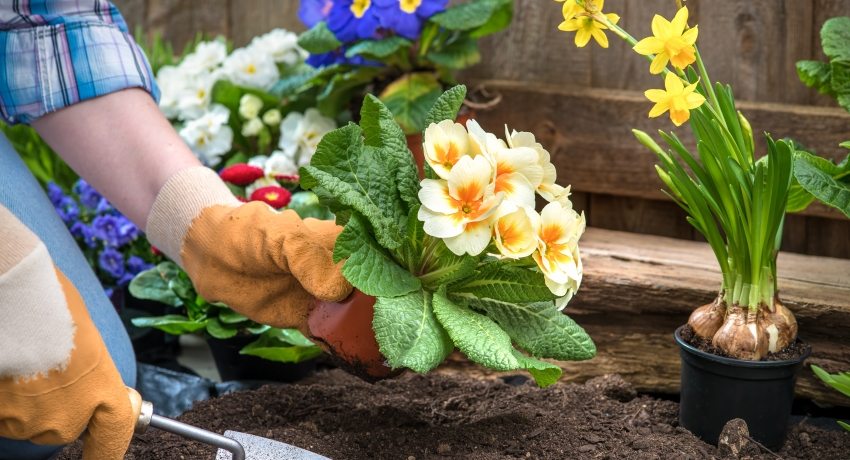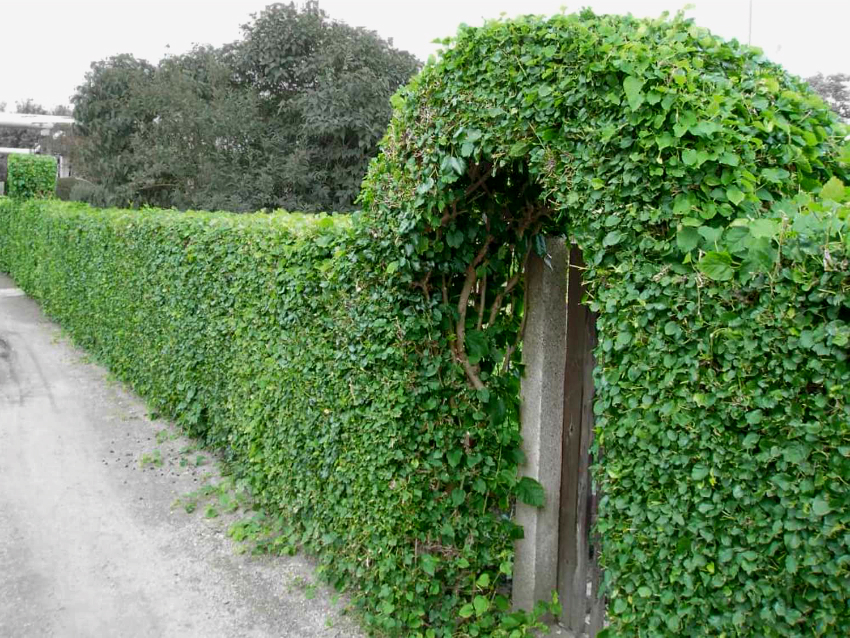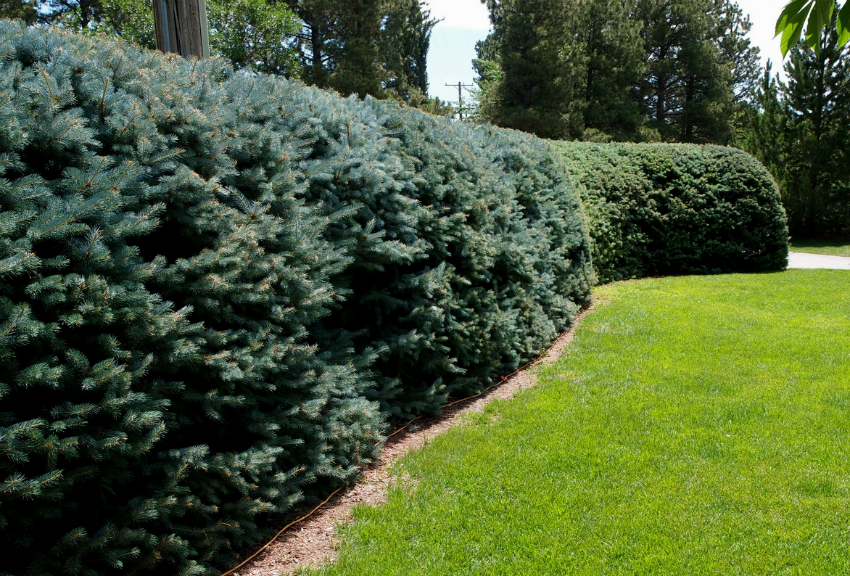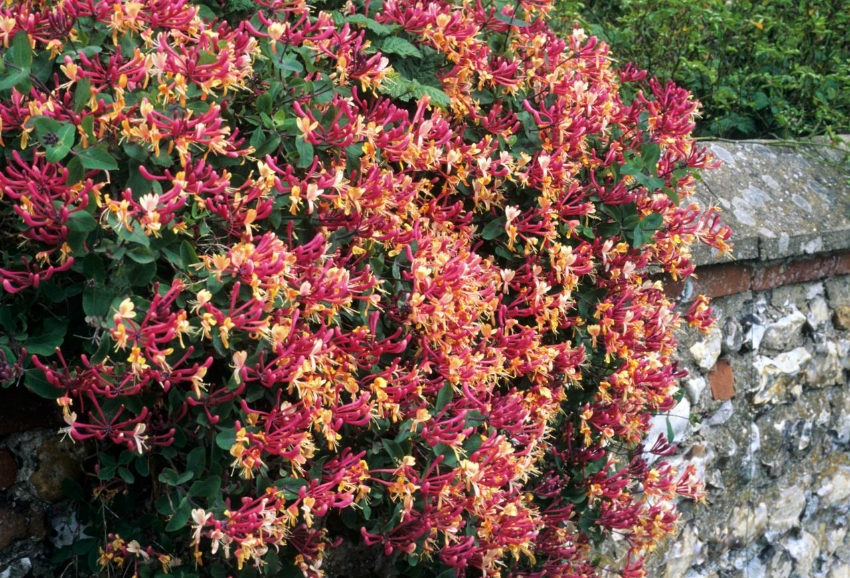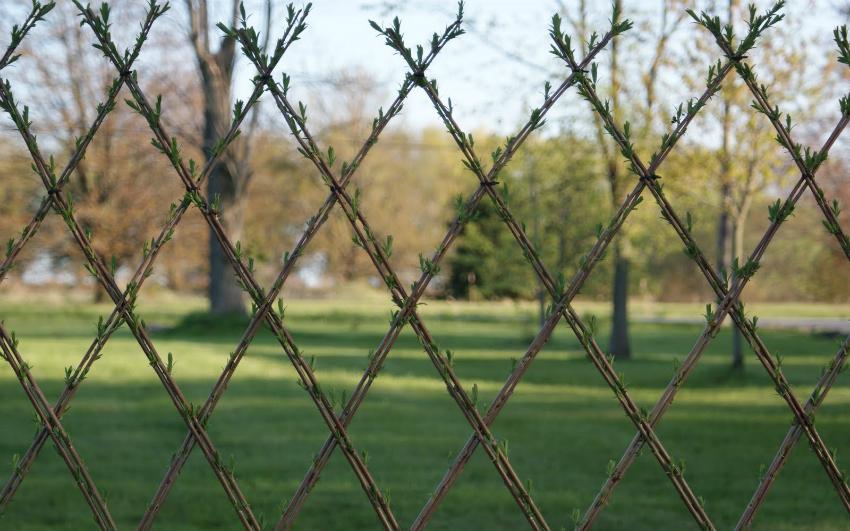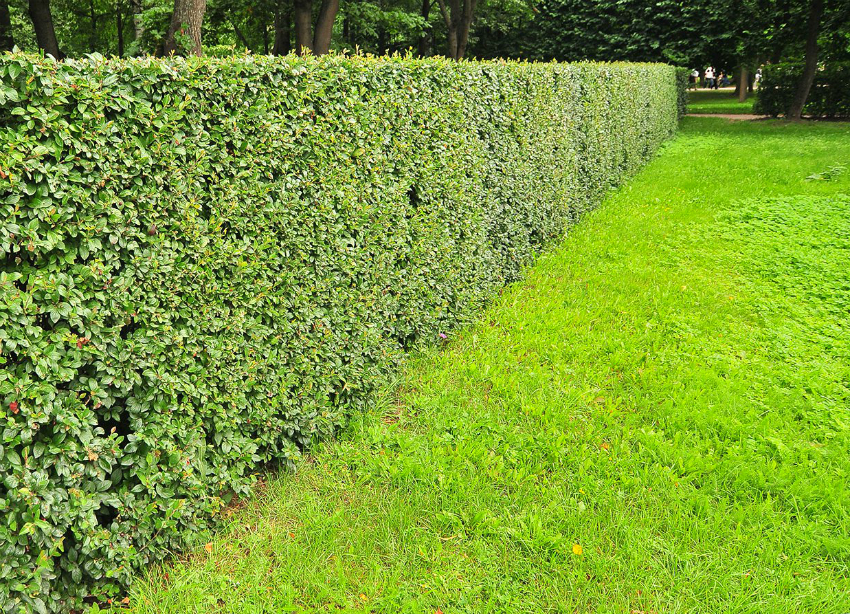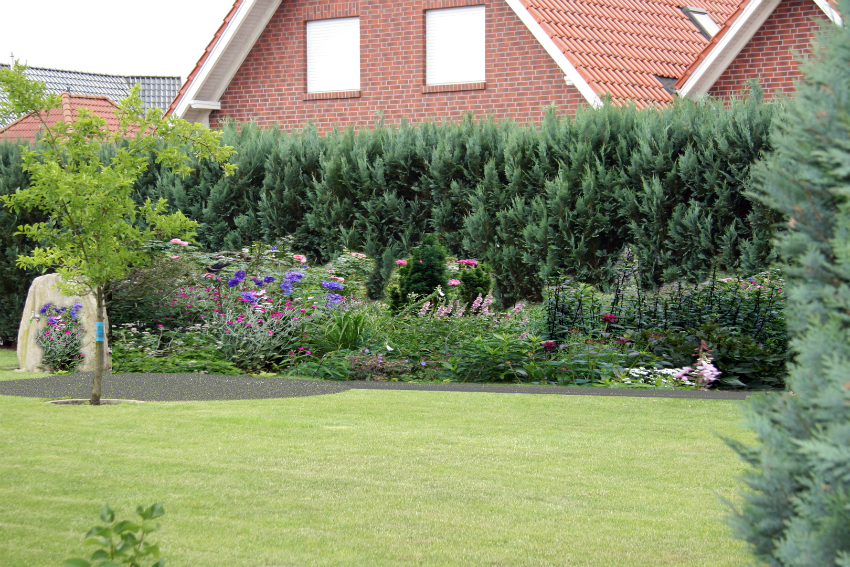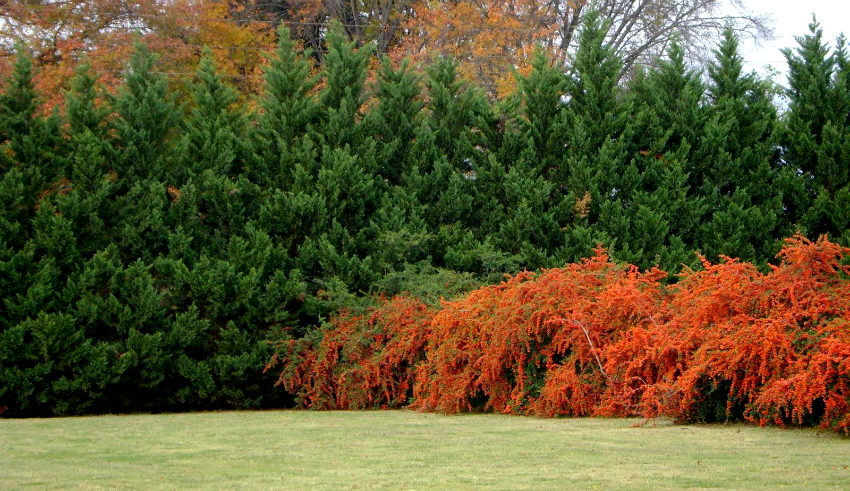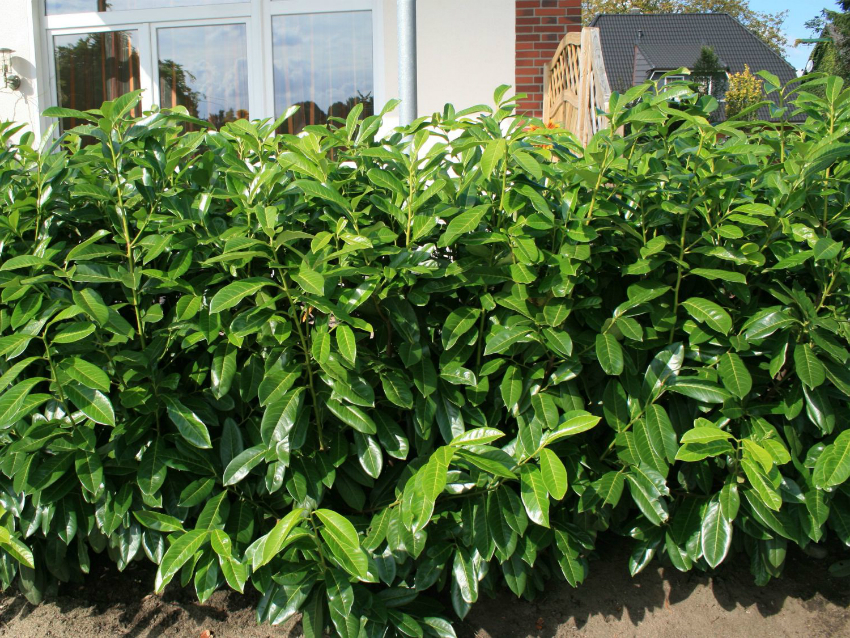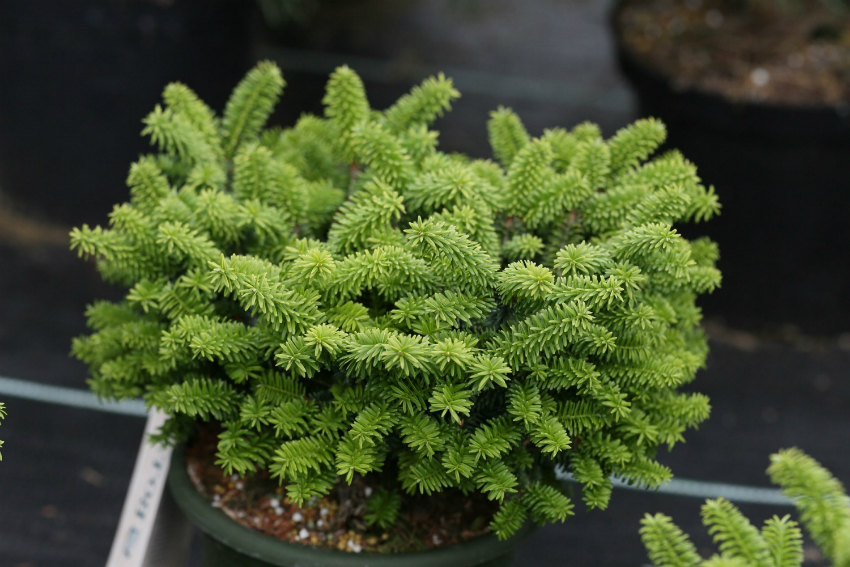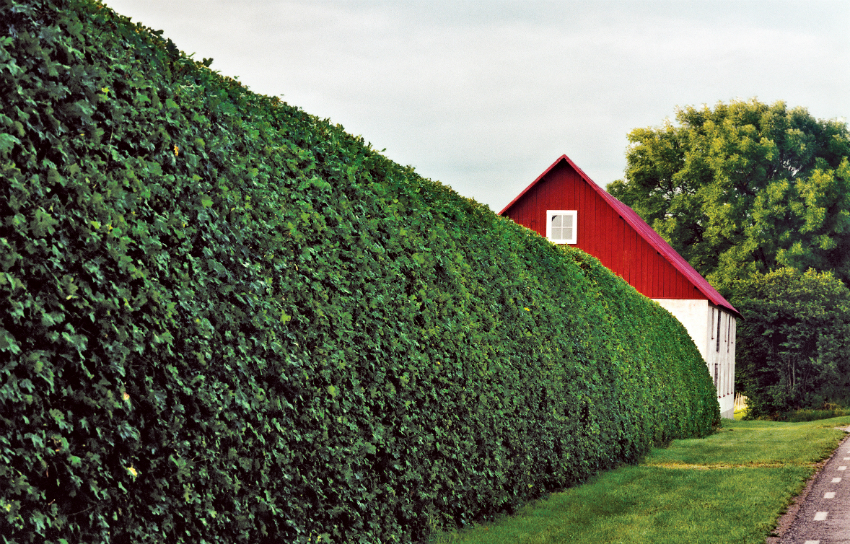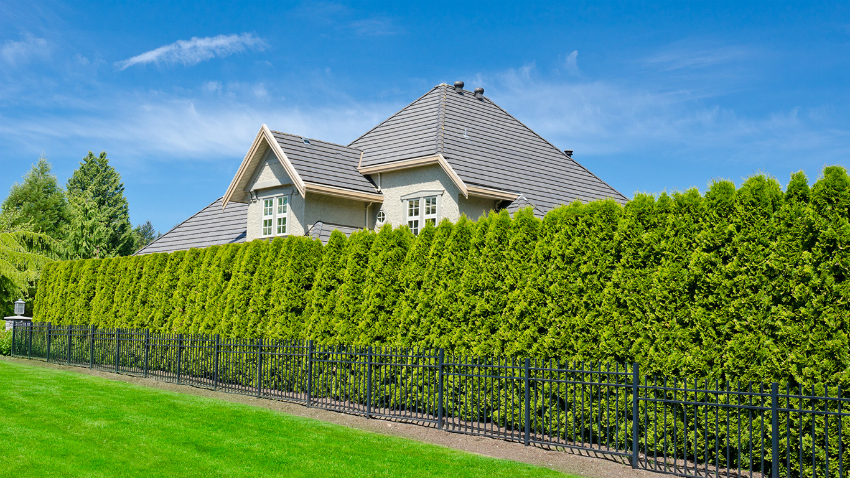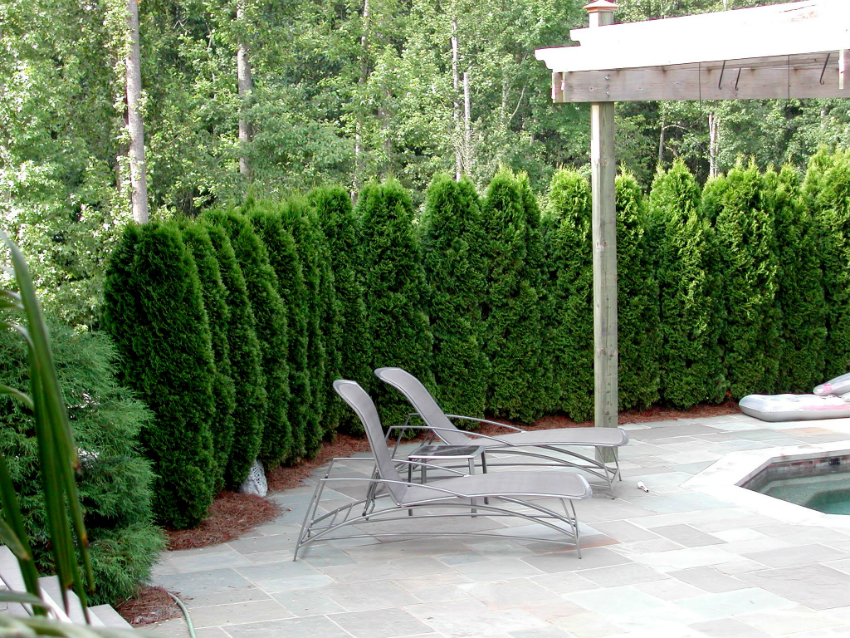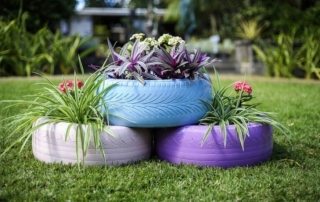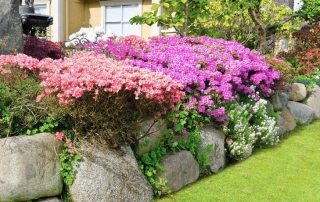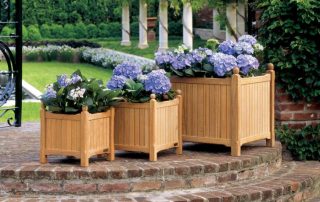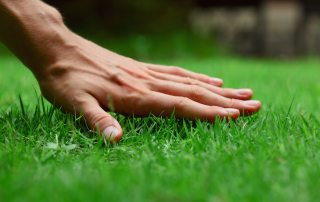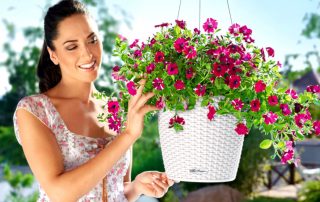A worthy alternative to heavy concrete and metal fences today has become a much more environmentally friendly hedge, which perfectly copes with all the functions of the fence and at the same time serves as a decoration of the site. Consider how a perennial fast-growing hedge can be independently made: what kind of evergreens are best used and how to properly care for them.
Content
- 1 Perennial fast growing hedge: evergreen shrubs and trees
- 2 Do-it-yourself hedge in the country: what plants can be used
- 3 Trees and shrubs for hedges: photos and names of fast-growing plants
- 3.1 Barberry: planting and caring for a shrub
- 3.2 Periwinkle: photos and recommendations for care
- 3.3 Euonymus: planting and caring for a hedge
- 3.4 Privet: a hedge made from this plant
- 3.5 Hawthorn for hedges: buy seedlings or grow it yourself
- 3.6 Spruce: conifer hedge
- 3.7 Honeysuckle honeysuckle: photos and tips for growing
- 3.8 Willow: a weeping tree hedge
- 3.9 Large-flowered campsis: planting and care
- 3.10 Cotoneaster brilliant: photo of a hedge
- 3.11 Lawson's cypress: green coniferous fence
- 3.12 Cupressocyparis Leylanda: an evergreen hedge of trees
- 3.13 Lavrovishnya: photos, recommendations and features of cultivation
- 3.14 Holly: photo, planting and caring for the bush
- 3.15 Balsam fir: care features
- 3.16 Garden ivy: a photo of a hedge and the nuances of growing
- 3.17 Boxwood: planting and caring for hedges in the garden
- 3.18 Thuja Brabant: photo, description and recommendations for growing
- 3.19 Thuja Smaragd: hedge from this plant
- 4 Perennial fast growing hedge: general tips
Perennial fast growing hedge: evergreen shrubs and trees
The main advantage of using green spaces instead of traditional fences is their appearance. Luscious greenery will surely please the eye, and at the same time protect your site from dust from the road. Moreover, the shrubs will actively produce oxygen, which is also an important argument in favor of this choice.
Here are some more benefits of a hedge:
- a bush fence copes well with the masking function, due to its fairly high density;
- during the period of pollination of flowers, the hedge serves as a bait for beneficial insects;
- to create a full-fledged hedge of fast-growing plants, you do not need to wait too long;
- thorny shrubs for hedges allow you to create fences that are impenetrable for humans and animals;
- a fairly large variety of existing perennial garden shrubs that bloom all summer.Photos and names contained in the catalogs allow you to choose an option that will decorate the site during the warm season.
At the same time, it is important to understand that the care of such a fence will be quite specific due to the fact that the plants require care: haircuts, feeding, and sometimes watering. However, if you consider that a traditional fence also requires attention and periodically you have to paint and repair it, we can say that the costs of effort and time are almost the same.
Do-it-yourself hedge in the country: what plants can be used
Many different plants are used to create a hedge. Sometimes you can find variants in which small trees are used. In many ways, the choice depends on your financial capabilities, as well as individual preferences. Consider the two main groups into which all plants used for this purpose are divided.
Coniferous plants. Due to their ability to stay green at all times, these shrubs are very popular with hedgerowers. It is important to pay attention here that only decorative varieties are suitable for this purpose. It is also worth taking into account the peculiarities of growing each species: some conifers grow better in shade conditions, while others prefer sunny places.
Useful advice! It is not recommended to plant conifers if your site is dominated by clay soil or groundwater is located close to the surface. In addition, it is worth keeping a certain distance between the bushes: 25-55 cm.
The second group of plants, deciduous, offers a much greater variety. Due to the high growth rate, already in the first year after planting, they will reach a sufficient height to fully fulfill the role of a hedge.
In the process of caring for a deciduous fence, the following factors should be considered:
- green spaces of this type can develop in completely different ways, therefore, in the process of growth, attention should be paid to their formation;
- if you use climbing plants, then it is worth taking care that your own and neighboring beds do not suffer from them;
- you can plant fruiting varieties of shrubs or trees;
- planting bushes with thorns and thorns can provide you with additional protection against the entry of strangers into the area.
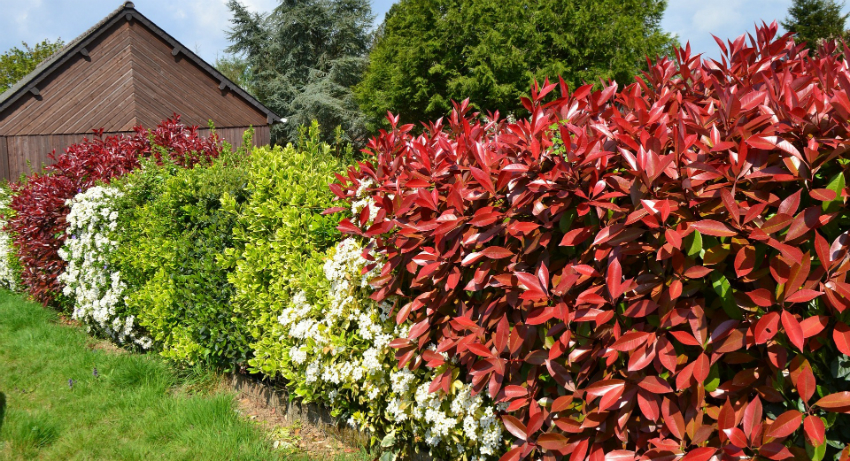
Thanks to the wide variety of plants, a hedge can become a colorful and interesting element of the site.
When making a choice, it is worth taking into account the many factors available, including climate, soil type and site relief. It is also better to ask in advance how the plants you have chosen get along with each other.
Trees and shrubs for hedges: photos and names of fast-growing plants
In order to make the right choice, you need to briefly familiarize yourself with all the existing options. It is enough to get a general idea of the requirements of a particular plant, and you can easily determine the most suitable one.
We will mainly consider those options that are relevant in the Moscow region. The fast growing hedge plants on this list are quite capable of surviving in the local climate.
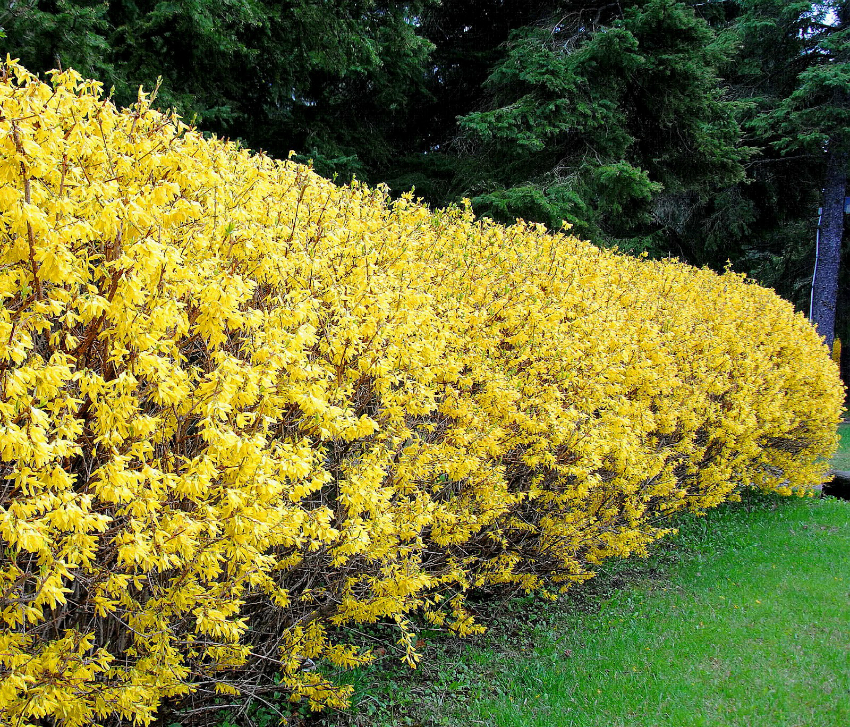
Plants for hedges must be selected according to the type of soil and climate where they will be planted
Barberry: planting and caring for a shrub
It is preferable to plant barberry bushes in the spring, however, in rare cases, autumn planting is also allowed. The barberry hedge is extremely unpretentious and requires minimal maintenance. Not afraid of wind and drafts. The only thing that is an undesirable factor for barberry is the increased acidity of the soil.
The instructions for caring for barberry bushes are universal for absolutely all varieties and species. During normal times, the plant does not require additional watering, but during periods of extreme heat or drought, you can moisten the soil once a week. It is important to try to avoid getting water on the leaves.
Excessive rainfall is much more dangerous for barberry bushes than drought. This is due to their ability to accumulate water and rot. For this reason, it is advisable to regularly get rid of growing weeds and loosen the soil.
You can start pruning a year after planting the bushes, removing weak and dry branches. This procedure has both formative and sanitary significance, so it must be carried out.
Periwinkle: photos and recommendations for care
Periwinkles are classified as herbaceous plants with erect shoots or creeping dwarf shrubs. They have many different colors (most often blue, but there are also pink, purple, white inflorescences), bloom in spring.
Cultivation and care do not cause any difficulties. Planting periwinkle in the open field can be carried out almost at any time of the year: in spring, late autumn, and even on cloudy summer days. The plant is not too sensitive to external factors and takes root well both in sunny areas and in shaded areas.
Additional watering is not required periwinkle, unless you take into account periods of prolonged drought, which are rare. The rest of the time, the flowers are quite capable of taking care of themselves. Weeds are also not a hindrance to them, so weeding can be done solely on their own. It is important to trim the plant after a long flowering period to help it renew and form.
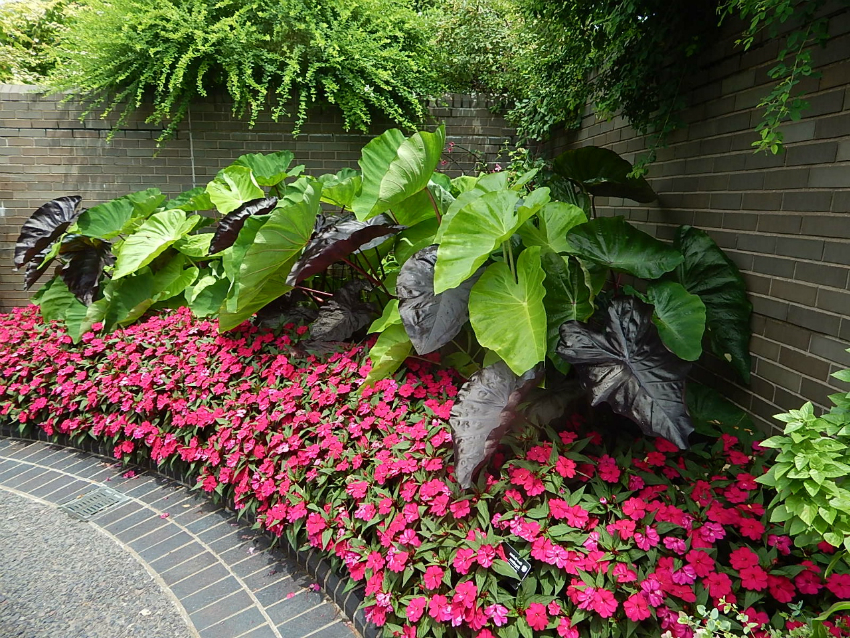
Periwinkle is a resilient and reliable plant, used to decorate curbs and strengthen uncool bare slopes
Euonymus: planting and caring for a hedge
Euonymus is a whole genus of plants that includes both shrubs and trees. To create a hedge, bushes are often used. Their main difference and advantage is the unusually beautiful color of the leaves, which can combine red, orange, yellow, white and purple shades.
Euonymus belongs to the category of fruiting plants, but its fruits cannot be eaten due to the presence of toxic substances. However, as a decoration of an autumn garden, its fruits look simply incomparable.
Shrub maintenance involves regular pruning and removal of dry, damaged branches. Forming a fence, euonymus allows you to create not only smooth borders, but also to give it a wide variety of geometric shapes. Additional watering is not required for the plant, but it can be sensitive to frost at a young age. Therefore, it is better to cover newly planted bushes in case of frost.
Privet: a hedge made from this plant
Privet is one of the most popular fast growing hedge shrubs. This is an unpretentious plant that easily takes root in shaded areas. It also copes well with drought. The only thing that can become an obstacle to full-fledged growth is excessive dryness of sandy soils or their increased acidity.
Opinions are divided over the best time to transplant privet. Some argue that it is best to do this in the spring, before the new cycle begins and the buds open. Others believe that transplanting is more reliable in early or mid-fall.
The main principle on which privet watering is based is a rare but abundant supply of moisture to the soil.With the exception of especially dry periods of summer, natural precipitation is quite enough for this plant, so there is no need for additional watering.
It is also worth buying privet because it is ideal for mastering the technique of curly cutting of bushes, since it can easily hide all inaccuracies and shortcomings, very quickly giving new shoots.
Useful advice! As soon as the bush planted in the ground takes root, it is necessary to cut the top so that it is thicker and does not grow too high.
Hawthorn for hedges: buy seedlings or grow it yourself
Not everyone knows about the possibility of creating a hedge using hawthorn bushes for this. For this, certain varieties of it are used, which are able to survive in rather harsh climatic conditions, and have a fairly dense crown that can be formed.
This plant prefers open sunny meadows, as a lack of natural light can cause the bush to not bloom. However, the hawthorn is quite frost-resistant. Its stems are covered with thorns, and after flowering, the fruiting period begins, characterized by the appearance of orange or reddish fruits.
Related article:
Catalog of perennial flowers for a summer residence: photo with names and descriptions of plants
Photos with the names of plants will help you navigate in a huge variety of flowers and make the right choice for your site.
The best time to plant hawthorn bushes is spring. It is during this period that it is best to carry out all earthwork. But here it is important to understand that hawthorn does not belong to fast-growing plants and therefore the period for growing a full-fledged hedge can be up to 10 years.
You need to start pruning and shaping from the fourth year of the plant's life, after which you regularly maintain its shape. This can be done at any time of the year, depending on the need. For this purpose, you can use an ordinary pruner.
Spruce: conifer hedge
The popularity of spruce hedges is due to several factors, the main of which is the ability of this tree to always remain green. Unlike deciduous bushes and trees, which fall off by autumn, spruce trees can hide your site from prying eyes at any time of the year.
Other advantages of this solution include:
- conifers have a very positive effect on the environment, helping to clean the air and neutralizing unpleasant odors;
- such a fence serves as a reliable protection from both dust and snow in the cold season;
- conifers are quite resistant to various kinds of diseases;
- clipping and shaping of fir trees should not be done too often. This is due to the rather slow growth rates.
Despite all these advantages, it is worth noting that ate, like many other conifers, prefer a humid climate. They do not respond very well to dry soil.
Honeysuckle honeysuckle: photos and tips for growing
Honeysuckle - one of the varieties of honeysuckle, which belongs to the type of "vines". Its height can reach 6 m, and the color of the shoots can vary from green to red. The flowering period of this plant is late spring and early summer.
Note!The fruits of honeysuckle, honeysuckle, are poisonous and unsafe to eat.
If you want a honeysuckle hedge to bloom actively, it is best to choose an open, sunny place for it. The spring months are best for planting.In order for the plant vines to form a full-fledged fence, it is necessary to install special supports.
A neutral acidic soil is best suited for honeysuckle. This plant does not like the soil with a high clay content or excessively dry. At the same time, a fairly high resistance to frost is noted.
Caring for honeysuckle honeysuckle involves removing weeds, watering regularly and abundantly, as well as pruning and shaping.
Willow: a weeping tree hedge
A natural willow fence is one of the simplest options you can find. This is due to the unique ability of this tree to take root even from twigs. That is, in order to create a full-fledged hedge, you do not need to plant traditional seedlings with an already formed root system. It is enough just to stick a willow twig into the moist soil and soon it will sprout by itself.
After the twigs sprout and take root, your main task will be to monitor the formation and, if necessary, limit the growth of trees. Another property of these plants is an extremely high growth rate, which, on the one hand, allows you to create a full-fledged hedge in the shortest possible time, and on the other, requires constant attention and control.
Useful advice!In order to make a living fence more reliable, it is perfectly acceptable to use a wire that is attached to the vertical supports of the fence. Thanks to the greenery, it will be hidden, however, it will prevent unwanted guests from entering the site.
Large-flowered campsis: planting and care
Among the people, Kampsis has several more names, for example, tekoma or tube flower. The plant belongs to the category of tree-like perennial deciduous lianas and in some cases can reach 15 m in length. In the process of growth, young shoots twine around the supporting pillars in a spiral, and then, having become woody over time, retain their shape.
The long flowering period of this plant is also pleasing - from June to September. Almost all summer you can enjoy scarlet or bright orange inflorescences, consisting of individual flowers that resemble small gramophone in shape.
Warmth and an abundance of sunlight are considered favorable for the growth of Kampsis. And although the plant is able to survive in almost any soil, a slightly acidic or neutral environment is considered the most favorable for it. In this case, flowering will be more abundant.
Vines of kampsis grow very quickly, so it is absolutely impossible to neglect pruning. The growth of the fence must be constantly monitored by pruning and guiding the vines. In addition, it is advisable to remove old branches to make room for new ones more suitable for flowering.

Kampsis vines grow very quickly, so it is better not to plant them right in front of the windows of the house
Cotoneaster brilliant: photo of a hedge
The most important thing to understand for gardeners who have decided to use a shiny cotoneaster for a hedge is that this plant is not at all the same as an ordinary cotoneaster. And this species will definitely not be able to provide you with edible berries. Looking at a photo of a brilliant cotoneaster, you can see how beautiful such a fence looks.
The cotoneaster itself is a bush, which is formed by erect stems, densely spaced together. The maximum height that this shrub is capable of reaching is 2 meters, however, you will have to buy a shiny cotoneaster in the form of seedlings. Moreover, its crown is very thick and fluffy.
It is necessary to take care of the brilliant cotoneaster regularly. This includes watering, loosening the soil and obligatory shearing of shrubs.It is worth noting, though, that as the bushes take root and grow, they require less and less attention. So, over time, you can refuse watering, with the exception of periods of severe drought.
Sanitary pruning, designed to remove all unnecessary and old branches, you can do at any time, regardless of the season. This must be done both for the purpose of forming and for rejuvenating shrubs. The main formative pruning is carried out mainly in the spring, before the first buds appear.
Useful advice! During the spring pruning process, it is recommended to eliminate one third of the growth in order to allow the plant to grow fully, while maintaining the desired hedge shape.
Lawson's cypress: green coniferous fence
Lawson's cypress can be confidently called one of the most beautiful conifers that are used to create a hedge. If you pay due attention to the choice of a planting site, in the future you will not have any difficulties with growing it.
The ideal location for this cypress tree can be considered a clearing located near a permanent source of water. These plants are very fond of moisture and constantly need it. In addition, it is highly desirable that the landing site also be protected from strong winds.
In the summer, each tree requires daily watering at the rate of 8-10 liters. In addition, you can additionally spray the crown with water. Fertilize the plant with mineral and organic fertilizers at least once a month.
Formative pruning is carried out in the spring, while removing all dried twigs and controlling growth. At the same time, fertilizing can be carried out to support the plant.
Cupressocyparis Leylanda: an evergreen hedge of trees
Cupressocyparis Leylanda is an evergreen plant, which is a tree, the height of which can reach 20 m. The crown of these trees is dense and has a symmetrical shape with shoots hanging down. The plant can grow up to 1.5 m per year, so it is classified as a fast-growing group.
Cupressocyparis lives quite calmly in the shade and has few requirements for external conditions. If we talk about the most favorable environment for him, then he prefers moderate humidity and soil saturated with minerals. As for acidity, this indicator does not really matter. In the dry season, young trees need periodic watering, and the rest of the time natural precipitation is enough for them.
Useful advice!Planting trees in open ground can be carried out only after their root system is sufficiently well developed. Until then, they must be kept in special containers.
Lavrovishnya: photos, recommendations and features of cultivation
In search of fast-growing shrubs for hedges, many pay attention to a plant such as cherry laurel. Most of its species grow rather slowly, but officinalis laurel is an exception and therefore is used by gardeners quite often.
We should also note the beauty of the flowers of this plant. Long (up to 12 cm) inflorescences consist of a large number of small flowers and give a decorative and aesthetic appearance to the hedge.
Lavrovychny perfectly withstands any difficulties, including severe frosts. Shade-tolerant enough, but demanding on the presence of moisture. If the soil is too dry for a long period, the plant will cease to bloom and bear fruit, and it will grow worse.
A fast growing cherry laurel hedge requires pruning and shaping twice a year. The first time this must be done at the end of next summer after planting seedlings.
Holly: photo, planting and caring for the bush
Holly is a shrub that has dark green foliage with a glossy finish. Its leaves are thorny, which makes it possible to create an almost impassable fence, the height of which can reach several meters. The plant is unpretentious and can fully grow and develop both in conditions of a sufficient amount of sunlight and in partial shade.
A hedge of holly bushes is formed over 4-5 years, provided that sufficiently developed plants have been planted in the soil. At the same time, in the process of planting, it is necessary to maintain a distance of about 60 cm between the bushes in order to enable them to grow.
Planting can be done twice a year: in autumn (October-November) or in spring (in April). But pruning is recommended in the middle of summer (best at the end of July).
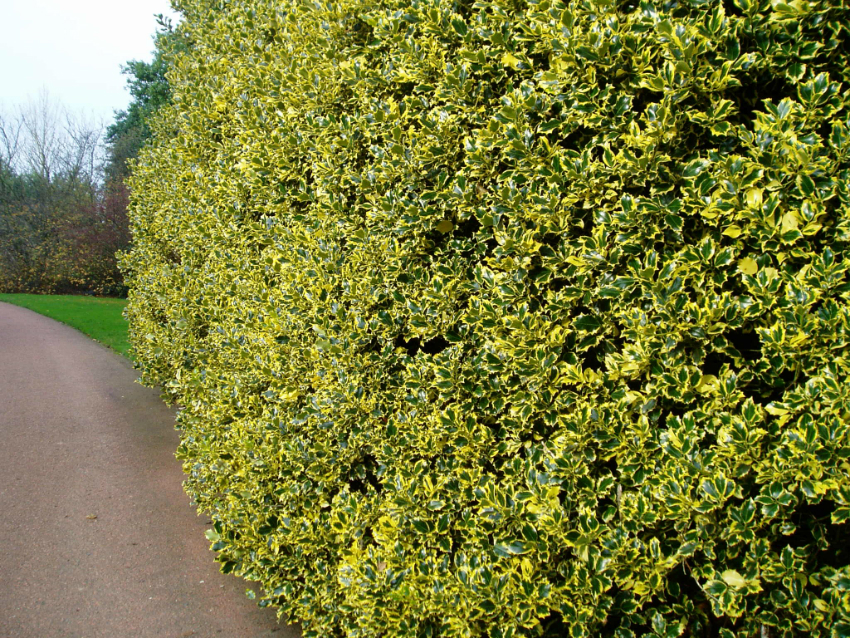
Holly, or holly, is prized for the decorative effect of shiny leathery leaves and bright attractive berries that can be red, yellow, or white.
Balsam fir: care features
Balsam Fir is a plant that prefers to grow in shaded areas. Shade or partial shade works well for her. Also, the close location of the reservoir will positively affect its development. This is due to the fact that the fir loves moist, well-drained soil rich in microelements. At the same time, stagnation of water in the soil is not permissible for this plant.
For planting in open ground, seedlings are used, which are at least 4 years old. Landing is best done in April, but it is worth choosing a cloudy day for this. Preparation should be started early by digging holes of a suitable size two weeks before disembarkation.
Despite the fact that fir is quite resistant to frost, sudden changes in temperature can provoke frostbite on the trunk of the tree. To prevent this from happening, it is recommended to cover the plants with spruce branches for the period of severe frosts. Of course, this applies more to young plants.
Useful advice! It is important to remember that the root system of fir is rather shallow, so strong winds can damage the plant. In the process of planting, it is better to select places where the trees will be protected from strong gusts.
Garden ivy: a photo of a hedge and the nuances of growing
Garden ivy is one of the most unpretentious plants you can find for a hedge. Planting and growing it will not cause any trouble to the owners. The plant grows excellently both in the shade and in the sun. However, it does not tolerate high humidity and severe frosts very well, so it is advisable to cover the plant for the winter.
The choice of a landing site is carried out on the basis of the following criteria: no drafts and strong winds, mainly a hill. At first, ivy grows rather slowly, adapting and getting used to new conditions. Therefore, planting is best done in early spring, so that during the summer months the plant has the opportunity to gain strength.
Garden ivy does not require frequent watering. Even during periods of drought, 1-2 times a week will be sufficient. Closer to autumn or during periods of natural precipitation, it is worth giving up this.
Useful advice! To maintain the health of the plant's root system, immediately after the rains, it is recommended to loosen the soil to prevent the formation of dense areas that will not allow moisture and oxygen to freely penetrate to the roots.
Boxwood: planting and caring for hedges in the garden
Boxwood is an incredibly beautiful shrub that allows you to create unique hedges in garden areas. At the same time, this plant has requirements, the observance of which will allow to grow healthy and beautiful bushes. So, the most suitable is the soil with moderate moisture and sandy loam or loamy composition. Boxwood reacts poorly to the increased acidity of the soil.
An increased level of groundwater also has an adverse effect on the development of the root system. As for the plant's love for direct sunlight, here we can definitely say that boxwood prefers shaded areas, although creating a hedge, it can be difficult to comply with this condition.
Boxwood should be planted in the spring. For this purpose, it is necessary to prepare trenches, the depth of which will be twice the size of the root system of the seedling. During planting, pay attention to the condition of the root system, as well as the crown of the plants.
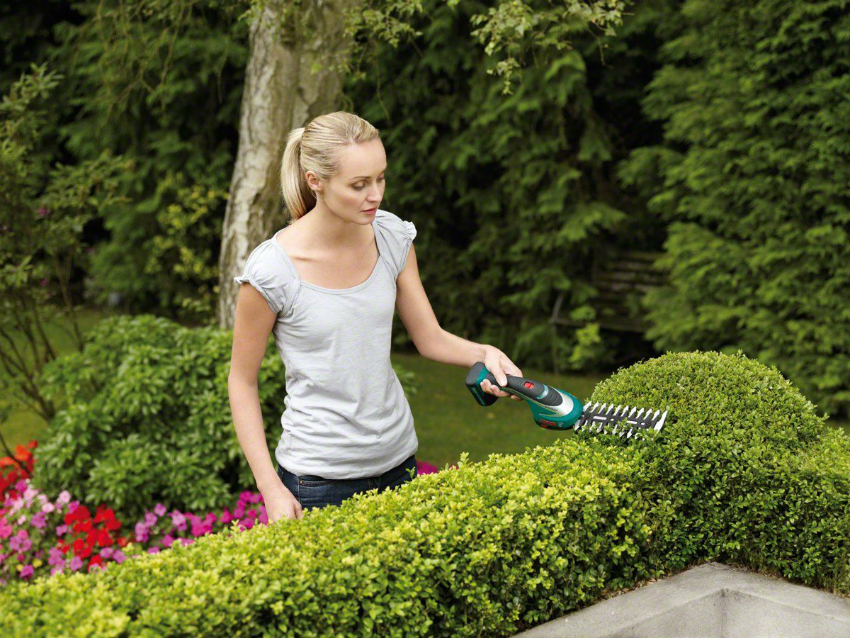
With the help of special tools, you can beautifully shape the crown of the bush and adjust its height
Thuja Brabant: photo, description and recommendations for growing
Thuja Brabant is an ornamental plant that cannot be called whimsical, but at the same time it requires compliance with a number of planting and maintenance conditions in order to maintain its functions. First of all, it is worth paying attention that this thuja does not tolerate shade well. A lack of sunlight can cause the plant to lose its original bright green color.
At the same time, intense heat is no less harmful. The ideal option is partial shade, when the plant is part of the daylight hours under the influence of sunlight, and the rest of the time is hidden in the shade. This can be achieved by planting a thuja on the west or east side of any building on the site.
Taking into account the peculiarity of the shape of these plants (wide crown and tapering upwards), planting of seedlings for hedges should be done at a distance of more than 50 cm from each other. So you won't be able to save space in this case.
Dry depleted land cannot become a worthy basis for growing thuja, which, in terms of its decorative characteristics, can meet all the requirements, and most importantly, your expectations.
Thuja Smaragd: hedge from this plant
Having made a choice in favor of thuja for a hedge, it is worth considering another variety of this plant as an option. Thuja Smaragd can reach a height of 3-5 meters. Moreover, its girth will reach 2 m. Such serious dimensions of an adult plant should be taken into account in the process of planting seedlings, leaving a sufficient gap between them, even if in the end you want to get a dense green hedge.
The tree grows rather slowly and the annual growth for it does not exceed 10 cm in height and 5 cm in width. Thuja can live for 150 years. As for the conditions, the trees are quite unpretentious, and can grow both in sunny areas and in shade.
Which thuja is better for a hedge - everyone decides for himself, based on their appearance, as well as the conditions available on the site. But one thing is for sure - both the Brabant thuja hedge and the fence from its brother Smaragd will be an excellent decoration of your site throughout the year.
Perennial fast growing hedge: general tips
As can be seen from the above list, many plants are quite unpretentious and require increased attention from owners only at the stage of choosing a suitable place and planting. In the future, only periodic pruning will be required to keep the fence in good shape.
Buying hedge shrubs is also easy enough.Garden centers or greenhouses that grow seedlings of shrubs and trees are best suited for this purpose.
What is better to make a hedge
After reviewing the photos and names of fast-growing trees and shrubs for a summer residence, you can assess which of the options is preferable for you. It is worth making a choice based on the following criteria:
- available conditions for plant growth: type of soil, illumination of the site, climatic features, amount of precipitation, etc.;
- the amount of time and attention you are willing to devote to caring for your hedge. Different trees and bushes for hedges require different efforts from the owners. If you are not ready to devote a lot of time to this issue, it is better to give preference to the simpler option, which will allow you to get by with formative pruning once or twice a year;
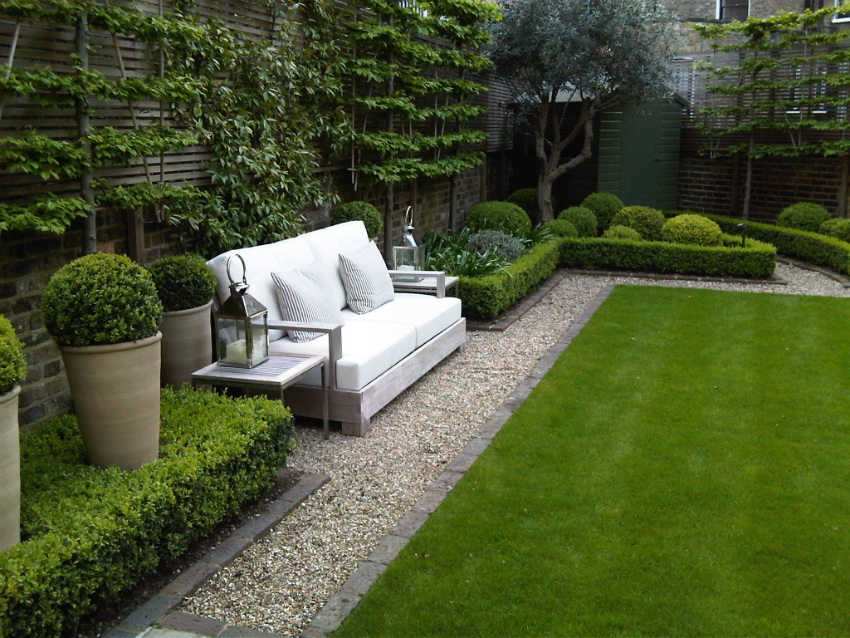
A beautiful green hedge is formed over several years under the condition of constant care of the plants
- the aesthetic component is an equally important aspect of the choice. Much depends on how you see your site fencing, whether you want an evergreen or deciduous plant, etc.
The selection of fast growing hedge plants is large enough that it shouldn't be too difficult to find the right one for you. The main thing is to consider as many photos as possible with the names of perennial bushes for the garden and vegetable garden, the cutting of which implies formation. And after you make a choice in favor of one or another option, read the detailed instructions on how to make a hedge with your own hands using one or another plant.
